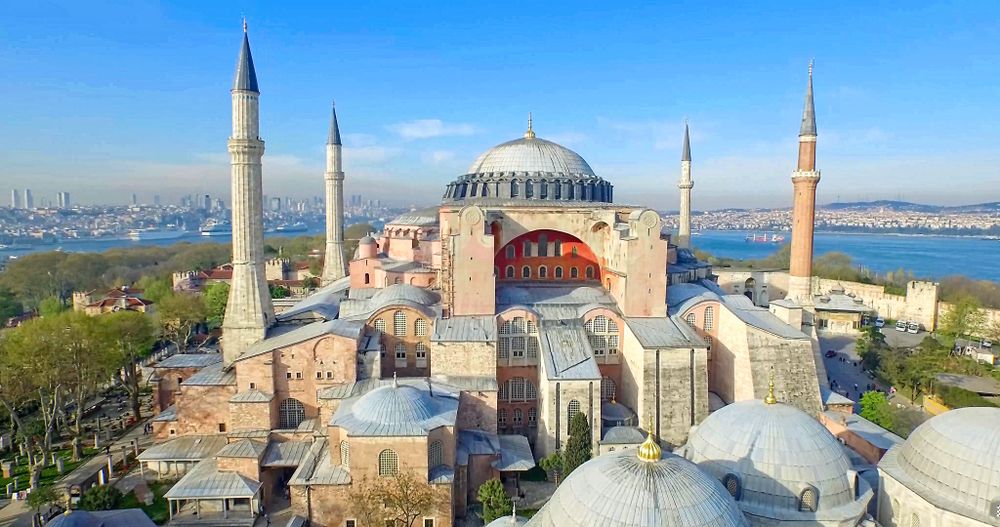Hagia Sophia, the Basilica and Byzantine jewel of Istanbul

Hagia Sophia was an old Orthodox basilica that was later converted into a mosque, although today, since 1935, it is a museum in the city of Istanbul. Its history also tells us the history of the city, and its architecture borders on the impossible.
Brief history
Hagia Sophia (meaning ‘Holy Wisdom’), was initially a mosque of the ottoman empire. Later, with Emperor Constantine the Great, the first christian emperor.
It became a Byzantine church, and was one of the largest buildings in the world in its time. But, unfortunately, nothing of this original church of the fourth century has been preserved.
Constantius, son of Constantine, and Emperor Theodosius the Great, built a second church, which was burned in 532.
The current Hagia Sophia was erected between 532 and 537 by Emperor Justinian I and is a perfect example of Byzantine architecture.
The dome of this church collapsed during an earthquake, in 558, and was rebuilt in 563, although it was damaged again in the following centuries.
For 900 years, Hagia Sophia was the seat of the Orthodox Church of Constantinople. In 1204 the Crusaders expelled the patriarch of Constantinople, replacing him with a Roman apostolic bishop, and sacked the church.
Many of the stolen treasures are displayed today in San Marcos, Venice.
In 1453 Sultan Mehmet conquered the city and turned Hagia Sophia into the main mosque in Istanbul, a site he kept for 500 years.
In 1934 President Kemal Atatürk secularized Hagia Sophia and turned it into the Ayasofya Museum (Ayasofya Müzesi)
Hagia Sophia Interior
The Hagia Sophia plant is that of a classical basilica, a rectangle with a central dome, with four scallops that make the transition to the square floor. On the sides of the central dome there are two semi-domes. The gallery under the dome has 40 lighting windows.
In the Byzantine era, Hagia Sophia was decorated with mosaics representing the Virgin Mary, Jesus, the saints and the emperors. Upon becoming a mosque, the mosaics were covered.
It was with the restoration of 1847 that they were discovered under the plaster, but they could not be completely restored until 1931. The most famous are in the upper floor galleries, including the Deësis with the Christ Pantocrator.
Wooden medallions with Islamic calligraphy are preserved, suspended from the central dome, with the names of Allah and Muhammad, and the first four Caliphs.
Curiosities of Hagia Sophia
For almost a thousand years it was the largest church in the world, until the Seville Cathedral was built.
Its amazing dome is 33 meters in diameter and 56 meters high.
All mosques in Istanbul follow the architectural schemes of Hagia Sophia, that’s why they look so alike.
In the southern gallery there is a rectangular column with the imprint of a hand whose author is unknown. There are those who believe it was from the Virgin Mary.
It would be the largest mosque in Istanbul if it were not a museum today, Atatürk turned it into a didactic institution to support its maintenance with the price of admission.
It would also be the fourth largest church in the world if it were not a museum, behind Saint Paul of London, Saint Peter of Rome and the Cathedral of Milan.
Visit to Hagia Sophia with a guide
Get to know all the details of the old basilica of Hagia Sophia and marvel at its architecture and the beauty of the complex with its four minarets.
An expert guide will explain all the important details, and you will not queue, and you will have the opportunity to see some incredible panoramic views of the Blue Mosque, a place that you will also visit on this guided route.
Practical Guide
Schedule:
Winter: Tuesday to Sunday from 9:00 a.m. to 5:00 p.m.
Summer: Tuesday to Sunday from 9:00 a.m. to 7:00 p.m.
Location: St. Sophia Square (Istanbul)
Tram: Sultanahmet
Free the first Monday of each month.



